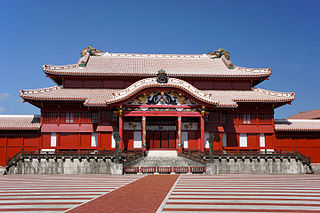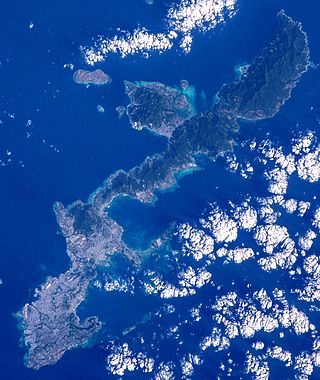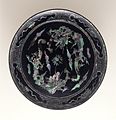
The Ryukyuan people are a Ryukyuan-speaking East Asian ethnic group native to the Ryukyu Islands, which stretch between the islands of Kyushu and Taiwan. Administratively, they live in either the Okinawa Prefecture or the Kagoshima Prefecture within Japan. They speak one of the Ryukyuan languages, considered to be one of the two branches of the Japonic language family, the other being Japanese and its dialects.

This article is about the history of the Ryukyu Islands southwest of the main islands of Japan.

The Ryukyu Kingdom was a kingdom in the Ryukyu Islands from 1429 to 1879. It was ruled as a tributary state of imperial Ming China by the Ryukyuan monarchy, who unified Okinawa Island to end the Sanzan period, and extended the kingdom to the Amami Islands and Sakishima Islands. The Ryukyu Kingdom played a central role in the maritime trade networks of medieval East Asia and Southeast Asia despite its small size. The Ryukyu Kingdom became a vassal state of the Satsuma Domain of Japan after the invasion of Ryukyu in 1609 but retained de jure independence until it was transformed into the Ryukyu Domain by the Empire of Japan in 1872. The Ryukyu Kingdom was formally annexed and dissolved by Japan in 1879 to form Okinawa Prefecture, and the Ryukyuan monarchy was integrated into the new Japanese nobility.

Okinawa Island, officially Okinawa Main Island, is the largest of the Okinawa Islands and the Ryukyu (Nansei) Islands of Japan in the Kyushu region. It is the smallest and least populated of the five main islands of Japan. The island is approximately 106 kilometres (66 mi) long, an average 11 kilometres (7 mi) wide, and has an area of 1,206.98 square kilometers (466.02 sq mi). It is roughly 640 kilometres south of the main island of Kyushu and the rest of Japan. It is 500 km northeast of Taiwan. The total population of Okinawa Island is 1,384,762. The greater Naha area has roughly 800,000 residents, while the city itself has about 320,000 people. Naha is the seat of Okinawa Prefecture on the southwestern part of Okinawa Island. Okinawa has a humid subtropical climate.

Shuri is a district of the city of Naha, Okinawa, Japan. It was formerly a separate city in and of itself, and the royal capital of the Ryūkyū Kingdom. A number of famous historical sites are located in Shuri, including Shuri Castle, the Shureimon gate, Sunuhyan-utaki, and royal mausoleum Tamaudun, all of which are designated World Heritage Sites by UNESCO.

The Ryukyu Islands, also known as the Nansei Islands or the Ryukyu Arc, are a chain of Japanese islands that stretch southwest from Kyushu to Taiwan: the Ōsumi, Tokara, Amami, Okinawa, and Sakishima Islands, with Yonaguni the westernmost. The larger are mostly volcanic islands and the smaller mostly coral. The largest is Okinawa Island.

Lacquerware is a Japanese craft with a wide range of fine and decorative arts, as lacquer has been used in urushi-e, prints, and on a wide variety of objects from Buddha statues to bento boxes for food.

The invasion of Ryukyu by forces of the Japanese feudal domain of Satsuma took place from March to May of 1609, and marked the beginning of the Ryukyu Kingdom's status as a vassal state under the Satsuma domain. The invasion force was met with stiff resistance from the Ryukyuan military on all but one island during the campaign. Ryukyu would remain a vassal state under Satsuma, alongside its already long-established tributary relationship with China, until it was formally annexed by Japan in 1879 as the Okinawa Prefecture.
Imperial Chinese missions to the Ryukyu Kingdom were diplomatic missions that were intermittently sent by the Yuan, Ming and Qing emperors to Shuri, Okinawa, in the Ryukyu Islands. These diplomatic contacts were within the Sinocentric system of bilateral and multinational relationships in the Sinosphere.

The Ryukyu Domain was a short-lived domain of the Empire of Japan, lasting from 1872 to 1879, before becoming the current Okinawa Prefecture and other islands at the Pacific edge of the East China Sea.

Kiyuna Tsugumasa was a politician of Ryukyuan descent who was active in Taiwan and Okinawa. He spent all his life seeking an independent Ryukyu; if could not reach that goal, he preferred to return to the Republic of China rather than Japan. He was also known by his Chinese style name, Tsai Chang.

Furusutobaru Castle is a Ryukyuan gusuku in Ishigaki, Okinawa. It is located on Ishigaki Island next to Miyara Bay. It was listed as one of the Historic Sites of Japan in 1978.

Ryūkyū Shintō-ki (琉球神道記) or An account of the ways of the gods in Ryūkyū is a five-volume treatise of c. 1605/6 by the Jōdo-sect Japanese priest Taichū Ryōtei (1552–1639), who lived in Naha from 1603 to 1606. Unlike most Okinawan literature, it predates the Satsuma invasion of 1609. A woodblock print edition was published in Kyoto in 1648.

The military of the Ryukyu Kingdom defended the kingdom from 1429 until 1879. It had roots in the late army of Chūzan, which became the Ryukyu Kingdom under the leadership of King Shō Hashi. The Ryukyuan military operated throughout the Ryukyu Islands, the East China Sea, and elsewhere that Ryukyuan ships went. Ryukyu primarily fought with other Ryukyuan kingdoms and chiefdoms, but also Japanese samurai from Satsuma Domain and pirates. Soldiers were stationed aboard ships and Ryukyuan fortifications. The Ryukyuan military declined after the 17th century until it was abolished following the Japanese annexation of Ryukyu in 1879.

The Ryukyuan mon was the currency used in the Ryukyu Islands. The Ryukyuan monetary system was based on that of China, like those of many nations in the Sinosphere, with the mon serving as the basic unit, just as with the Japanese mon, Vietnamese văn, and Korean mun. Like Japan had also done for centuries, the Ryukyuans often made use of the already-existing Chinese cash coins when physical currency was needed.
The flag of Ryukyu is a number of flags that represent the Ryukyu Kingdom, the Ryukyu Islands, and the Ryukyuan people.

The Ryukyu Disposition, also called the Ryukyu Annexation or the annexation of Okinawa, was the political process during the early years of the Meiji period that saw the incorporation of the former Ryukyu Kingdom into the Empire of Japan as Okinawa Prefecture and its decoupling from the Chinese tributary system. These processes began with the creation of Ryukyu Domain in 1872 and culminated in the kingdom's annexation and final dissolution in 1879; immediate diplomatic fallout and consequent negotiations with Qing China, brokered by Ulysses S. Grant, effectively came to an end late the following year. The term is also sometimes used more narrowly in relation to the events and changes of 1879 alone. The Ryūkyū Disposition has been "alternatively characterized as aggression, annexation, national unification, or internal reform".

Okinawa (沖縄) is a name with multiple referents. The endonym refers to Okinawa Island in southwestern Japan. Today it can cover some surrounding islands and, more importantly, can refer to Okinawa Prefecture, a much larger administrative division of Japan, although the people from the Miyako and Yaeyama Islands still feel a strong sense of otherness to Okinawa.

The foreign relations of the Ryukyu Kingdom were shaped through heavy mutual contact and trade with surrounding nations, most notably Japan and China. The influence exerted by both of these nations differ throughout each era of Ryukyuan history. To a lesser extent, other nations played a role in Ryukyuan diplomacy.



















